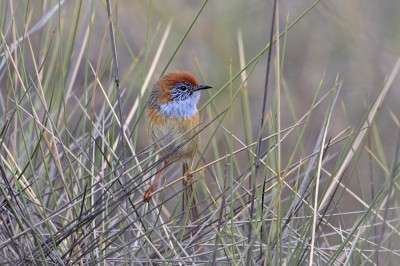Fires wipe out native wildlife

(Phys.org) —Devastating fires that swept across Victoria and South Australia during last month's heatwave have wreaked havoc on wildlife habitat killing entire populations of threatened native birds, and wildlife remain at risk as temperatures soar, ecologists warn.
Fires ignited two conservation parks in South Australia that were home to the only remaining populations of the endangered Mallee Emu-wren, a tiny bird with distinctive emu-like tail feathers. The fires completely engulfed the Billiatt Conservation Park with over 67,000 hectares burnt, while all remaining emu-wren sites within the Ngarkat Conservation Park burnt in two separate fires.
Lightening ignited a fire in the Victorian mallee, 12 kilometres southwest of Ouyen, burning the entire 13,000-hectare reserve that was home to the threatened black-eared Miner. This was one of only two small populations of the Black-eared Miner remaining in Victoria. The only other population of this species resides in the Riverland Biosphere Reserve, South Australia. Around 35 per cent of all Black-eared Miner habitat in the reserve was also burnt in another fire.
Ecologist Dr Rohan Clarke, from Monash University's School of Biological Sciences, said breeding and recovery programs were critical to protecting endangered species.
"The fact that we lost several significant bird populations in fires linked to a single heat wave event highlights just how vulnerable many of these species are," Dr Clarke said.
"Following the recent fires, the global population of the Mallee Emu-wren is now restricted to a single reserve system – one big fire could render the species extinct.
"Where wildfire is a threat it is absolutely critical that our eggs aren't all in one basket. To better manage risk we need well-funded recovery programs where the establishment of separate populations is a key measure of success."
Chair of the Black-eared Miner Recovery team Dr Rebecca Boulton, of the University of Adelaide, has led a decade-long recovery effort aimed at boosting numbers through captive breeding programs, the release of female birds into new colonies and habitat management.
"Fire, and its threat, is a familiar occurrence each summer for many Australian residents living amongst our flammable habitat," Dr Boulton said.
"For our wildlife, adaptation to fire is a common life-history strategy. Yet with land clearance, isolating and restricting many species distributions, large bushfires now seriously threaten many species survival.
"Birds like the black-eared miner and mallee emu-wren have little chance of ever naturally repopulating these burnt-out areas due to the highly fragmented mallee landscape, coupled with their limited dispersal capabilities."
Dr Clarke said Australia had the highest rate of mammal extinctions in the world, and few people realised how close many native bird species are to a similar fate.
"The recent review of Australia's bird fauna lists 27 bird species as extinct since European colonisation, with a further 20 classified as critically endangered and 60 endangered," Dr Clarke said.
Provided by Monash University


















